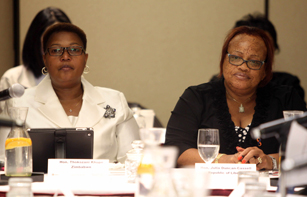
Credit: UNAIDS/D.Kwande
A mid-term review on the implementation of the Global Plan Towards the Elimination of New HIV infections among Children by 2015 and Keeping their Mothers Alive took place in Nairobi, Kenya from 6-7 December. The two-day workshop discussed the way forward in overcoming three key bottlenecks to achieve the Global Plan targets, including early infant diagnosis, human resources for health and supply chain management.
In June 2011, UNAIDS and the President’s Emergency Plan for AIDS Relief (PEPFAR) unveiled the Global Plan with two main targets for 2015: a 90% reduction in the number of children newly infected with HIV and a 50% reduction in the number of AIDS-related maternal deaths. The Global Plan focuses on 22 priority countries with the highest estimated numbers of pregnant women living with HIV.
Opening the meeting, US Deputy Global AIDS Coordinator Deborah Von Zinkernagel noted the momentum that has been gained in the 18 months since the launch of the Global Plan. “Strong political leadership, progressive policy change, and accelerated programmatic scale up at various levels are helping to significantly reduce new HIV infections among children and AIDS-related deaths among mothers,” said Ms Von Zinkernagel. “While the job is far from done, the intensified efforts of many partners under the Global Plan are advancing our progress towards the goal of achieving an AIDS-Free Generation”, she added.
Speaking about the challenges, participants highlighted that immediate confirmation of HIV infection in children is urgent to ensure timely initiation of antiretroviral therapy, as half of the children infected with the virus die before the age of two years. UNAIDS estimates that in 2010, among 65 reporting countries, only 28% of infants born to mothers living with HIV received an HIV test within the first two months of life. In 2011, 230 000 children died from HIV-related causes worldwide and only 28% of children eligible for treatment were receiving it, compared to 54% of adults.
Participants also stressed that, despite progress made in the provision of services to prevent mother-to-child transmission of HIV, access to appropriate diagnostics and/or treatment for pregnant women still remained inadequately low. According to UNAIDS, the percentage of treatment-eligible pregnant women living with HIV who were receiving antiretroviral therapy for their own health in 2011 was an estimated 30%.
In countries like the Democratic Republic of Congo, Chad, and Nigeria, less than 20% of pregnant women received HIV testing and counselling in 2010. Participants noted that, in some cases, the lack of access to these services is caused by uninformed or misguided government policies that do not prioritise the provision of this life-saving treatment.
Overall supply chain challenges, and in particular, the cost of commodities have overarching implications. Participants agreed that without an effective supply chain, the goals of the Global Plan are impossible to meet. Strategies such as pooling and integrating procurement, strengthening and harmonizing regulatory systems, systems transparency, and improving the accuracy of commodity forecasting to reduce stock wastage are critical to maximize supply chain efficiency. The meeting also discussed the importance of predictable funding and skilled personnel to enable efficient logistics management while lowering costs.
A shortage of human resources for health, including doctors, nurses and midwives was discussed as a major bottleneck in rapidly expanding HIV prevention, treatment and support services for mothers and children. Many of the participating countries are experimenting with task-shifting and task-sharing, as well as working with community and lay health workers in order to stretch the reach of health care services. Strategies that can accelerate the recruitment, retention and retraining of health care providers were shared, such as formalizing the role of community health workers, the development of a formal professional management cadre to oversee health facilities, and accelerated pre-service training schemes.
While the job is far from done, the intensified efforts of many partners under the Global Plan are advancing our progress towards the goal of achieving an AIDS-Free Generation
US Deputy Global AIDS Coordinator Deborah Von Zinkernagel
Participants agreed that eliminating new HIV infections among children and keeping their mothers alive is not, and should not be, just about pills. It is first and foremost about protecting the health, dignity and security of mothers living with HIV and their children. They heard reports of human rights violations of women living with HIV such as mandatory HIV testing, forced sterilizations, as well as stigma and discrimination especially in the health care setting. Networks of women living with HIV demonstrated how they have been overcoming these challenges including sensitizing communities on their rights, demanding action and accountability from governments and other stakeholders, and playing a central role within their country programs to end vertical transmission. During the workshop, participants agreed on key actions required for progress to be made against the targets of the Global Plan in these areas. Participants also discussed the global financing architecture, and how to maximize towards available resources such as Global Fund and PEPFAR, but beginning with their own domestic funding.
Closing the meeting, the Director of the Department of Evidence, Innovation and Policy at UNAIDS Dr Bernhard Schwartlander, commended countries for their rapid momentum. “The call for elimination of new HIV infections among children by 2015 and keeping their mothers alive has been widely heard”, he said, “and countries are now making important and sustained investments for their populations. It is now time to notch up our efforts as we enter the second phase of the Global Plan, and be better accountable to our governments and the people we serve.”
The meeting was attended by government representatives from 16 of the 22 priority countries under the Global Plan, as well as representatives from PEPFAR, the UN, and several global implementing agencies. Others present included Women Fighting AIDS in Kenya (WOFAK), The International Community of Women with HIV/AIDS (ICW), and the Inter-Agency Task Team on the Prevention and Treatment of HIV among Pregnant Women, Mothers and Children.














